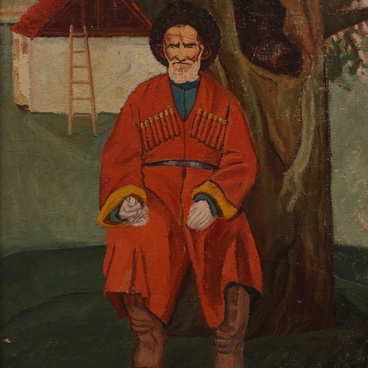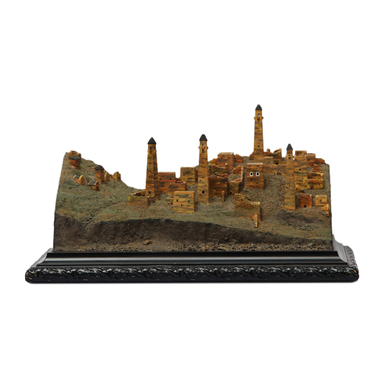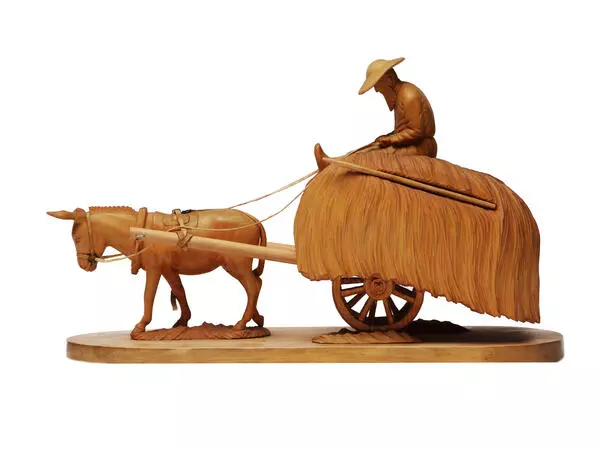Yusup Khamchiev is a prominent woodcarver in Ingushetia. In his sculptures, he mainly depicts stories about highlanders, as well as different animals and birds. He loves animalism as a genre and has stated more than once that the beauty of animals inspires him.
This sculpture depicts the West Caucasian tur — a mountain-dwelling goat-antelope that is endemic to the Caucasus. It differs from the domestic goat in its size: the West Caucasian tur is a lot bigger, and it has incredibly strong legs, perfect for climbing cliffs. This animal can climb into places which are unreachable for both predators and people.
The Latin name of this animal is Capra caucasica. According to zoologists, there are two types of Caucasian turs: the West Caucasian tur and the East Caucasian tur. It is easy to distinguish between the two by the shape of their horns: the West Caucasian tur’s horns are thicker and more curved, and they can reach one meter in length. The horns of the East Caucasian tur are not as curved, and rather they look like sabers with curved blades.
The sculpture depicts the first type. The master placed the animal on a mountain slope. He meticulously conveyed its structure: the unique shape of its eyes, ears, and hooves. The artist also left traces of his woodcarving tool on the surface of the sculpture to imitate the fur coat of the animal.
Woodcarvers choose different types of wood, of both deciduous and coniferous trees. When choosing, it is important to consider the special qualities of the wood: the presence of the heartwood, the width of the sapwood (the outer, less dense layer of wood which is located right under the bark), the visibility of the growth rings, the difference between early- and latewood, the presence of the medullary rays, the resin canals and many more. Every detail helps to understand whether the wood is suitable for carving with a cutting tool.
Yusup Khamchiev prefers linden. It has an aesthetically pleasing shade of white, and, if properly carved, its many medullary rays make the wood shiny. Linden is easy to cut along and across the grain, it rarely warps or cracks, and it is easy to paint and polish.
This sculpture depicts the West Caucasian tur — a mountain-dwelling goat-antelope that is endemic to the Caucasus. It differs from the domestic goat in its size: the West Caucasian tur is a lot bigger, and it has incredibly strong legs, perfect for climbing cliffs. This animal can climb into places which are unreachable for both predators and people.
The Latin name of this animal is Capra caucasica. According to zoologists, there are two types of Caucasian turs: the West Caucasian tur and the East Caucasian tur. It is easy to distinguish between the two by the shape of their horns: the West Caucasian tur’s horns are thicker and more curved, and they can reach one meter in length. The horns of the East Caucasian tur are not as curved, and rather they look like sabers with curved blades.
The sculpture depicts the first type. The master placed the animal on a mountain slope. He meticulously conveyed its structure: the unique shape of its eyes, ears, and hooves. The artist also left traces of his woodcarving tool on the surface of the sculpture to imitate the fur coat of the animal.
Woodcarvers choose different types of wood, of both deciduous and coniferous trees. When choosing, it is important to consider the special qualities of the wood: the presence of the heartwood, the width of the sapwood (the outer, less dense layer of wood which is located right under the bark), the visibility of the growth rings, the difference between early- and latewood, the presence of the medullary rays, the resin canals and many more. Every detail helps to understand whether the wood is suitable for carving with a cutting tool.
Yusup Khamchiev prefers linden. It has an aesthetically pleasing shade of white, and, if properly carved, its many medullary rays make the wood shiny. Linden is easy to cut along and across the grain, it rarely warps or cracks, and it is easy to paint and polish.





